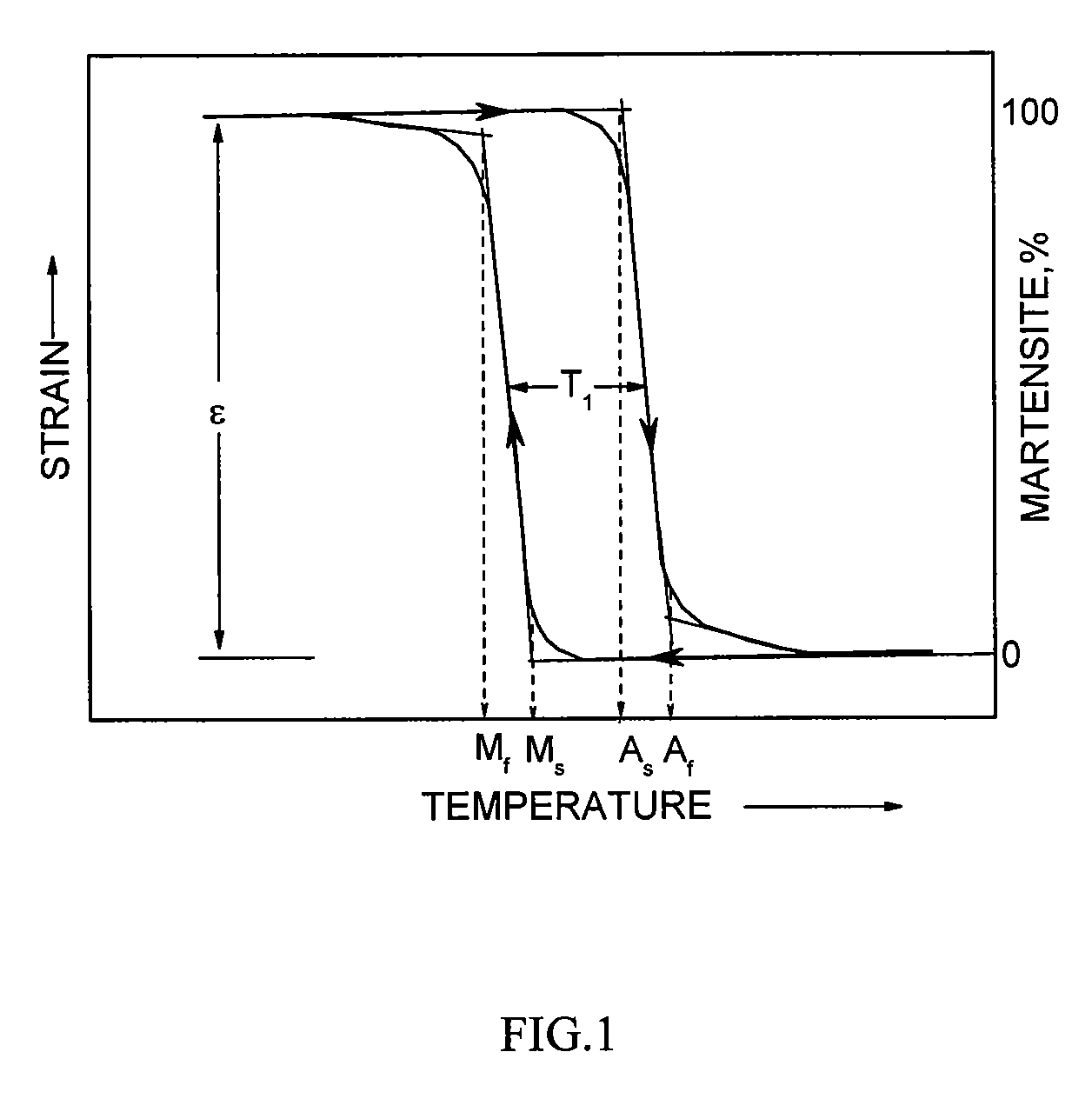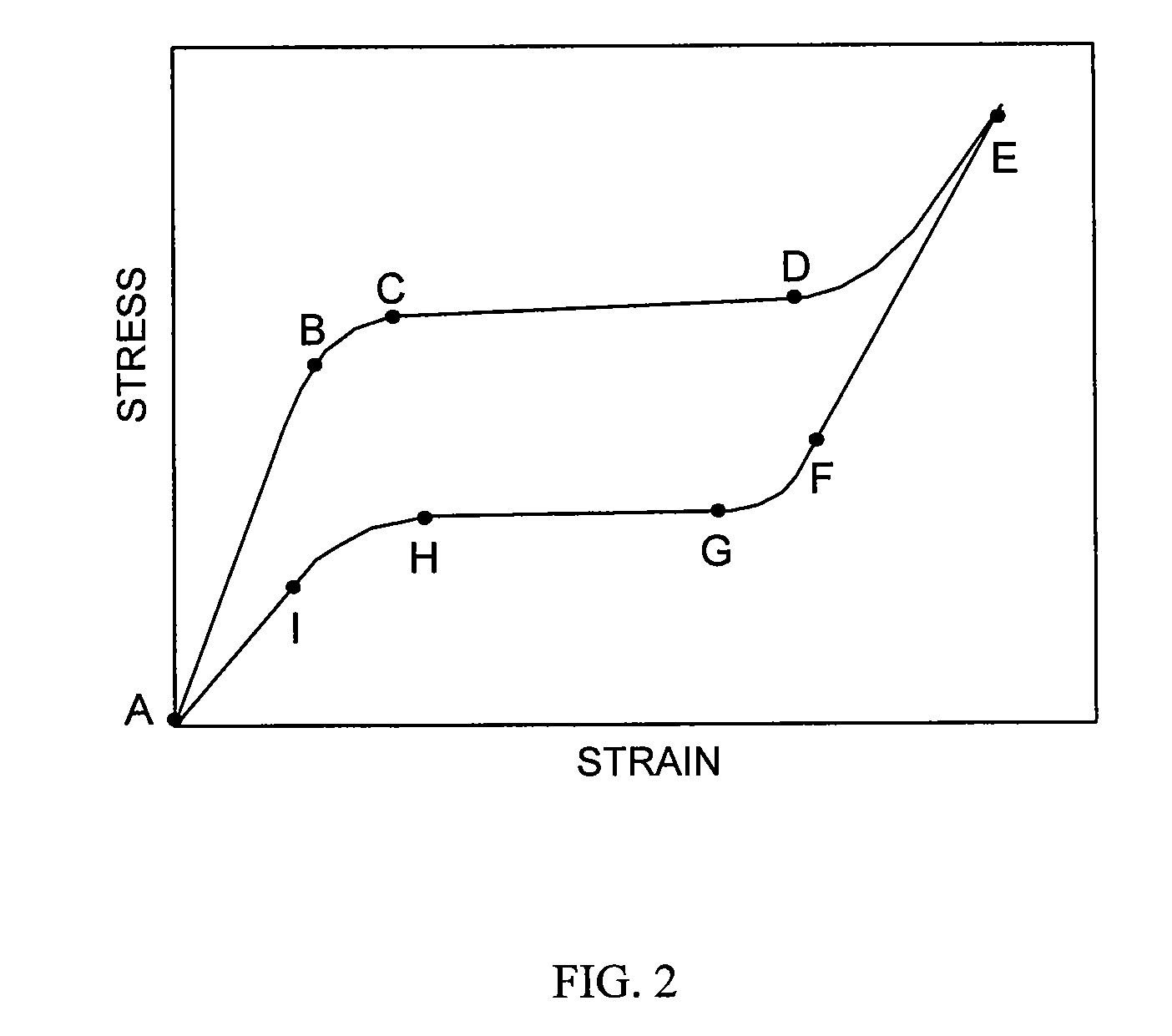Radiopaque alloy and medical device made of this alloy
a radiopaque alloy and medical device technology, applied in the field of metalurgical field, can solve the problems of insufficient radiopaque, limitations on the utilization of high-mass construction, and implants made of known smas, and achieve the effect of increasing radiopacity
- Summary
- Abstract
- Description
- Claims
- Application Information
AI Technical Summary
Benefits of technology
Problems solved by technology
Method used
Image
Examples
example 1.1
[0080]To broadly estimate the martensite start temperature Ms of a quaternary or quintary Ti—Ni alloy of interest, such as Ti49.5Ni22.2Au25.0Fe2.3Zr1.0, a change in the martensite start temperature Ms relative to the binary TiNi system can be derived for each alloying element (e.g., Au, Fe, and Zr) at the appropriate concentration using the data provided in FIGS. 3A to 5B, and then the respective changes may be summed as discussed in this and the related examples below.
[0081]For example, the martensite start temperature Ms of the alloy Ti49.5Ni22.2Au25.0Fe2.3Zr1.0 can be estimated on the basis of the corresponding temperature increments ΔT={Ms(Ti50.0Ni50.0−xMex)−Ms(Ti50.0Ni50.0)} for variations of Ts of ternary compositions of the Ti—Ni alloy alloyed with a ternary element (Me).
[0082]In calculations, the value of Ms(Ti50.0Ni50.0)≈55° C. for martensite start temperature of Ti50.0Ni50.0 was considered. According to the martensitic transformation diagram (shown in FIG. 3C), adding a ra...
example 1.2
[0088]The same procedure as described in Example 1.1 may be employed to estimate the transformation temperatures for a Ti48.7Ni35.0Au15.0Al1.3 alloy.
[0089]Referring to FIG. 3C, alloying a binary TiNi alloy with a radiopaque alloying element Au in the amount of 15 at. % by replacing 15 at. % of nickel increases Ms from about 55° C. for the binary TiNi system to approximately 100° C. for the Ti50Ni35Au15 alloy. Thus, Ms(Ti50Ni35Au15)≈100° C. and ΔTAu≈(100° C.-55° C.)=45° C.
[0090]Further, in order to decrease Ms and facilitate superelastic properties, for example, such an alloying element as Al can be used. Referring to the martensitic transformation diagram for Ti50.0−xNi50.0Alx of FIG. 5A, adding Al in the amount of 1.3 at. % by replacing 1.3 at. % of Ti decreases Ms from about 74° C. to approximately −37° C. for the Ti48.7Ni50.0Al1.3 alloy. Thus, Ms(Ti48.7Ni50.0Al1.3)≈−37° C. and ΔTAl≈(−37° C.-74° C.)≈−111° C.
[0091]Hence, the temperature Ms of the multi-component Ti48.7Ni35.0Au15.0A...
example 1.3
[0092]The same procedure as described in Example 1.2 may be employed to estimate the transformation temperatures for a Ti48.7Ni35.0Au15.0Cr1.0 alloy.
[0093]In order to fabricate a multi-component alloy based on titanium nickelide and having desired radiopaque property and desired martensitic transformation temperature, first, a binary TiNi alloy can be alloyed similar to Example 2 with a radiopaque alloying element Au in the amount of 15 at. % by replacing 15 at. % of nickel. As described in the previous example, this alloying increases Ms from about 55° C. to the temperature Ms(Ti50Ni35Au15)≈100° C. (i.e., by ΔTAu≈45° C.).
[0094]According to this example, in order to decrease Ms, an alloying element such as Cr can be used. For instance, it is known that adding Cr in the amount of 1.0 at. % by replacing 1.0 at. % of Ni decreases Ms to the temperature Ms(Ti50.0Ni49.0.0Cr1.0)≈−80° C. (i.e., by ΔTCr≈−135° C., assuming that the Ms of TiNi is 55° C.). Further assuming that adding Cr in the...
PUM
| Property | Measurement | Unit |
|---|---|---|
| Temperature | aaaaa | aaaaa |
| Fraction | aaaaa | aaaaa |
| Fraction | aaaaa | aaaaa |
Abstract
Description
Claims
Application Information
 Login to view more
Login to view more - R&D Engineer
- R&D Manager
- IP Professional
- Industry Leading Data Capabilities
- Powerful AI technology
- Patent DNA Extraction
Browse by: Latest US Patents, China's latest patents, Technical Efficacy Thesaurus, Application Domain, Technology Topic.
© 2024 PatSnap. All rights reserved.Legal|Privacy policy|Modern Slavery Act Transparency Statement|Sitemap



